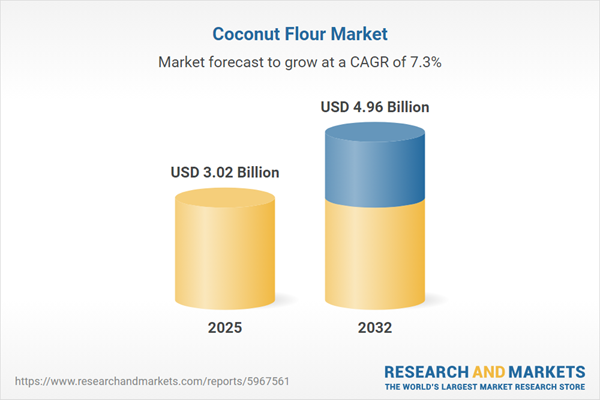Speak directly to the analyst to clarify any post sales queries you may have.
Navigating the coconut flour market presents both complexity and opportunity, with organizations adapting to regulatory evolution, supply chain intricacies, and the escalating preference for plant-based solutions. Senior leaders need clear market intelligence and agile strategies to successfully manage operations and drive growth.
Coconut Flour Market Snapshot
The global coconut flour market holds a valuation of USD 2.82 billion in 2024 and is forecasted to reach USD 4.96 billion by 2032, reflecting a compound annual growth rate of 7.32%. This expansion is supported by consumer demand for clean-label, plant-based products, which compels both established and emerging producers to reconsider and reformulate their strategic approaches. Shifting regulatory frameworks have amplified the importance of transparent sourcing and stricter quality requirements. Accordingly, businesses are optimizing compliance procedures and refining their production protocols to meet broadening expectations around wellness and resiliency throughout the competitive supply landscape.
Coconut Flour Market Scope & Segmentation
This report is built for procurement, operations, and executive teams seeking actionable data to guide investment, supply chain optimization, and competitive strategy. Understanding these market dimensions is essential for advancing organizational priorities across the value chain.
- Forms: Defatted coconut flour supports extended shelf life and specialty dietary applications. Granulated formats cater to texture modifications across product lines. Powdered versions are favored for high-volume, automated processes.
- Applications: Coconut flour’s versatility enables its use in bakery goods, gluten-free recipes, processed foods, dietary supplement blends, and confectionery, enhancing product differentiation.
- Distribution Channels: Sales are executed via direct online platforms, top e-commerce sites, pharmacies, specialty outlets, and major retail environments, covering varied customer profiles and expanding market reach.
- End Uses: Food and beverage leads demand, with growing uptake in personal care for its unique textural properties and in pharmaceuticals for selected functional implementations.
- Regions: The market is present in the Americas, Europe, Middle East, Africa, and Asia-Pacific. Key countries include China, India, Japan, and Australia, each representing distinct regulatory and logistical considerations that impact supply chain decisions.
- Technology: Automation and digital tracking are increasingly adopted, reinforcing compliance, traceability, and rapid operational adjustment capabilities aligned with global requirements.
Analyzing these segments enables decision-makers to calibrate procurement according to regional standards, improve supply flexibility, and support scalable, future-ready operating models.
Coconut Flour Market: Key Takeaways
- The adaptability of coconut flour supports broad utilization across mainstream and specialty product categories, accommodating dynamic shifts in health and sustainability priorities.
- Commitment to transparent sourcing and responsible supply chain practices encourages long-term partnerships and alignment with compliance frameworks.
- Advancements in process automation and technology drive product uniformity and facilitate effective responses to seasonal or market-driven demand fluctuations.
- Multi-channel distribution strategies, balancing direct and indirect sales, enhance global market penetration and buffer operational exposure to local disruptions.
- Collaborative approaches among suppliers, manufacturers, and logistics entities help ensure product availability and promote innovative developments in line with operational goals.
Impact of 2025 US Tariffs on Coconut Flour Supply Chains
Planned US tariffs on coconut-based imports will necessitate realignment of procurement models. Many organizations are expanding global supplier networks, pursuing domestic sourcing opportunities, and implementing automation in procurement and contract management. These responses collectively mitigate risks associated with trade disruptions, enhance continuity in commercial supply, and bolster readiness under new regulatory regimes.
Methodology & Data Sources
The findings in this report are supported by direct interviews with supply chain experts, rigorous trade data analysis, and regulatory assessments. All insights are validated using secondary research and robust modeling to deliver regionally reliable intelligence specific to the coconut flour market.
Why This Report Matters
- This report offers procurement teams critical guidance for fine-tuning sourcing policies and resource planning within complex regulatory frameworks.
- Executive leaders benefit from structured analysis that anticipates regulatory change, strengthening strategic direction and operational robustness across the coconut flour value chain.
- Strategic planners obtain data-driven foundations to inform technology adoption and shape adaptable, scalable business initiatives aligned with emerging trends.
Conclusion
Continued advancement in the coconut flour sector will rely on operational adaptability, focused process innovation, and enhanced collaboration across the supply ecosystem. Organizations that integrate technology and adaptive strategies will remain well-positioned to navigate regulatory shifts and future growth prospects.
Additional Product Information:
- Purchase of this report includes 1 year online access with quarterly updates.
- This report can be updated on request. Please contact our Customer Experience team using the Ask a Question widget on our website.
Table of Contents
3. Executive Summary
4. Market Overview
7. Cumulative Impact of Artificial Intelligence 2025
Companies Mentioned
The companies profiled in this Coconut Flour market report include:- Bob's Red Mill, Inc.
- Anthony's Goods, LLC
- Nutiva Inc.
- Barlean's Organic Oils, LLC (Let's Do Organic)
- Nature's Path Foods, Inc.
- Sresta Natural Foods Pvt. Ltd.
- Dr. Goerg GmbH & Co. KG
- SELVA Europe NV
- Nutriorg Private Limited
- Arroy-D Corporation
Table Information
| Report Attribute | Details |
|---|---|
| No. of Pages | 191 |
| Published | November 2025 |
| Forecast Period | 2025 - 2032 |
| Estimated Market Value ( USD | $ 3.02 Billion |
| Forecasted Market Value ( USD | $ 4.96 Billion |
| Compound Annual Growth Rate | 7.3% |
| Regions Covered | Global |
| No. of Companies Mentioned | 11 |









